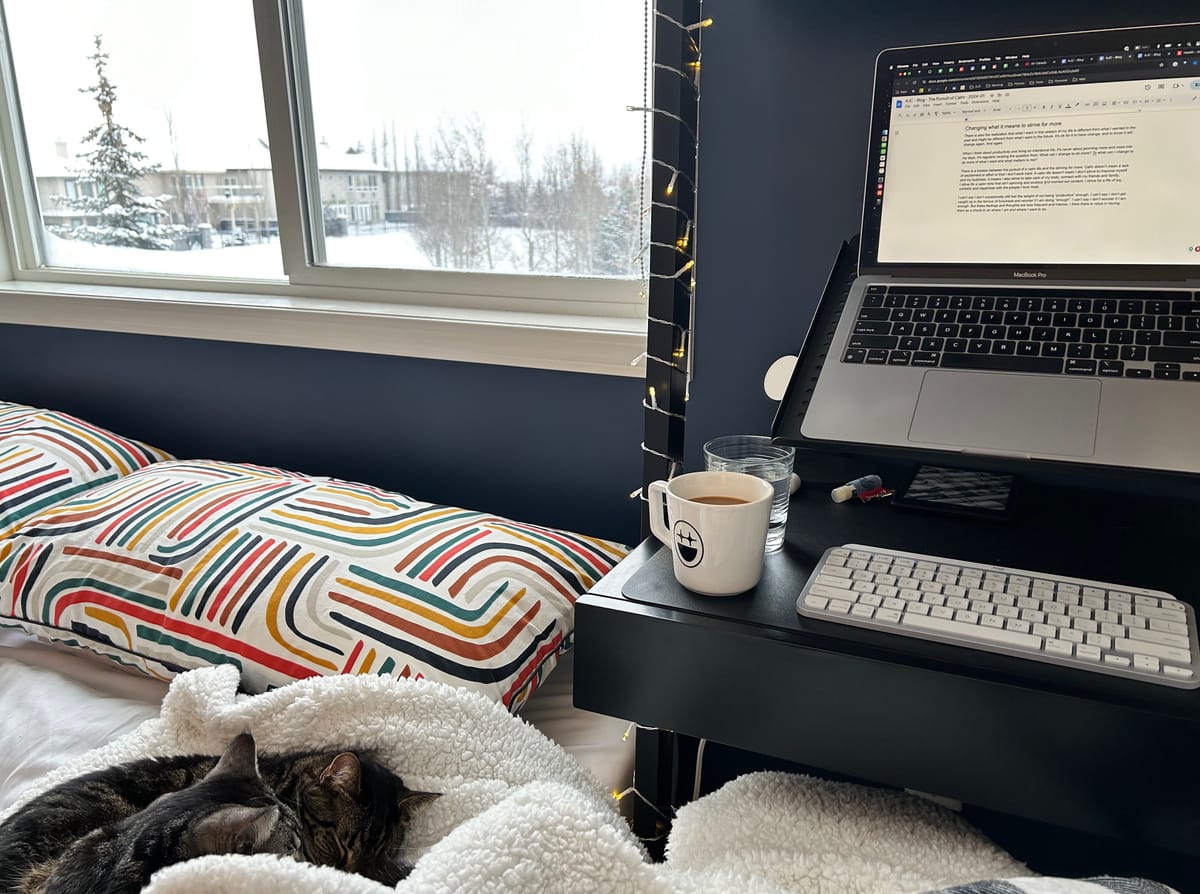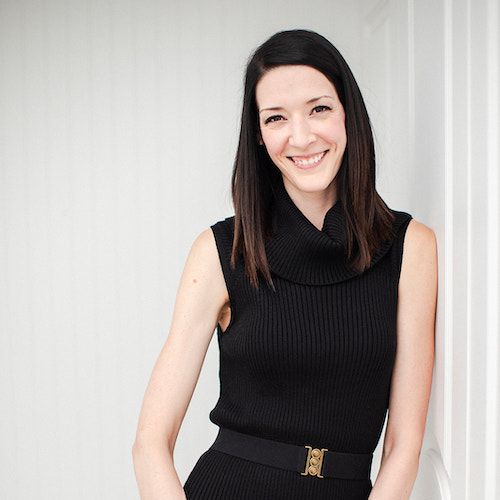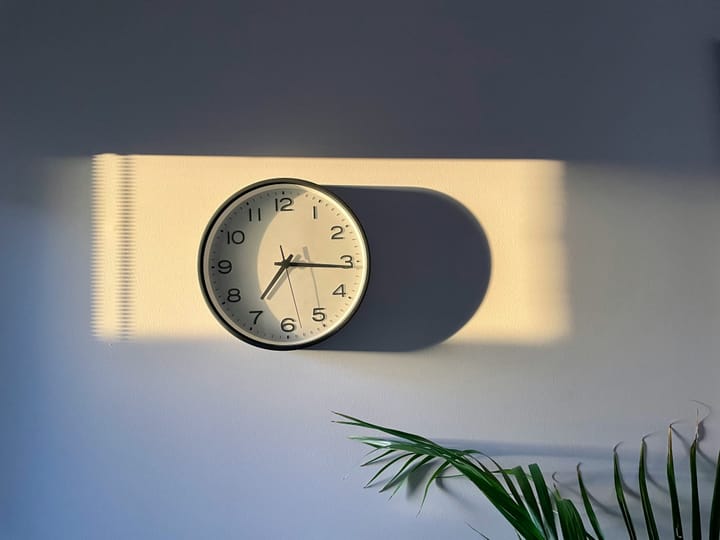4 Productivity Tools I Use Everyday
Though there is no tool or tactic that will get your life "under control", these are my favourites to help support an intentional life.

As the year soldiers forward, I thought it would be helpful to revisit some of the tools and tactics I have written about in the past – both for new readers who may not have seen them and also as a refresher for those of you who have been with me from the beginning. These are some favourites that I use daily to support my pursuit of a calm, intentional life!
Before I get into my list, I wanted to reiterate that there is no tool, tactic, software or productivity hack that will get your life under control. They are all in service of supporting habits and processes, which serve to make and keep space for what matters to you. What matters to you has to be established first. All those steps take significant time and effort to keep up with among the sometimes harrowing adventures we all face each day.
An intentional life is one of thoughtfulness, reflection, and deliberate choices. Everything I am about to share supports those choices but is otherwise a band-aid solution without the necessary pre-work.
Caveats established, these are my favourite productivity tools and tactics:
- Time blocking and my ideal week
- Strong calendar boundaries
- Daily reflection
- Gmail stars, multi-inbox and automatic filters
Let’s dig into each one!
1. Time blocking and my ideal week
The first exercise I have almost all my new clients go through is imagining their ideal week. The article below goes into detail about how to do it, but the gist is:
- Set up a new, blank calendar in your app of choice (Google Calendar, iCal, Outlook Calendar. etc)
- Time block your usual routines (sleeping, eating, hygiene, commute, kids activities etc.)
- Time block when you want to, in an ideal world, do other everyday activities
- Work activities, like email, meetings, focus time, planning, etc.
- Personal activities, like fitness, learning/reading, hobbies, etc.
- Time block when you could do things you are NOT doing but wish you were
- Make the blocks recurring, and then map your actual calendar over top
- Update the time blocks on an ongoing basis both as your ideal week evolves and with your todos/tasks
What I love about the ideal week, and why I use it for myself every day, is that:
- It acts as a reminder of how much time is actually available each day, given all the other things that are happening in my calendar
- It acts as a reminder of what I want to happen and to keep my boundaries as much as possible to help ensure they do
- It provides a tool to intentionally time-block specific tasks and responsibilities in my ideal time slots
The ideal week is just that- ideal. It’s never perfect, and I don’t follow it to the letter, but it’s a great tool for helping me be intentional about my time and energy.
Question: What would you include in your ideal week?
Related article: Time-Blocking and Imagining Your Ideal Week
2. Strong calendar boundaries
The most important part of keeping my ideal week as much as possible is establishing and keeping firm calendar boundaries to protect my focus and energy.
These are boundaries that I’ve identified as things that work best for my best mental energy times for focus work and to prevent myself from overbooking.
Mornings are for focus; afternoons are for meetings
My best focus time for writing and deep thinking work is in the mornings. Each week, I do my best to protect my mornings for those types of tasks. Because meetings tend to drain me, taking morning meetings hurts my productivity for later in the day. This means, as a general rule, I don’t take meetings in the mornings.
Of course, circumstances arise that require me to make exceptions, but I do my best not to limit my availability to afternoons.
No meetings on Mondays and Fridays
I further narrow my availability to not taking meetings on Mondays and Fridays. My no-meeting Mondays is a much looser boundary as an option, but Fridays are usually a hard and fast rule. I like to keep my Friday open as a day to get to anything that had to be pushed back over the week, a day I can prioritize learning and research time and also set intentions for the next week.
Max 3 meetings a day (2 is better) and 1 speaking gig every 2 weeks
Between my innate introversion and health considerations, I know that if I take too many meetings in a day or do too many speaking gigs too close together, I crash hard. I have learned this the hard way in the form of migraines and days where I can’t work at all because I overdid it. I still, sometimes, make terrible life choices and overcommit myself, but I try as best I can to stay within these limits. 😅
Calendly
The software tool that helps me keep to these boundaries is Calendly. It’s a meeting booking software that syncs with my Google Calendar, and I have set the rules above as my parameters. My free consultation only shows availability on days that I want it to. I can also block off days I know I don’t want anything booked on for whatever reason.
Question: What boundaries can you set to protect your focus and energy?
Related article: 8 Ways to Set Boundaries Around When You Schedule and Accept Meetings

3. Daily Reflection
Y’all know I am all about reflection. I often share my reflections on specific events and my annual reflection to set my themes each year. The other reflection I do that I get a lot of value from is my daily reflection.
There are many different formats, times and questions you can include in your daily reflection; there is no right or wrong way to do it. I do mine in a spreadsheet before I go to bed. It includes three parts:
- Health tracking
- Mood (Good/Bad/Mixed)
- Energy level (Good/Bad/Mixed)
- Sleep quality (Good/Bad/Mixed)
- Any MS symptoms
- Reflection Questions
- What went well today?
- What was tricky or didn’t go well?
- What am I grateful for today?
- Any other reflections: What did I learn? What would I do differently? What's the story from today?
This might seem like a lot, but it takes me about five minutes each night. What I like about the process of going through my daily reflection is:
- Even on tough days, it reminds me there are beautiful things about every day.
- Recording data gives context to how I’m feeling. For example, if I haven’t slept well in a few days, it makes sense that my energy levels are low. I also see patterns over time that I can plan around. For example, I know that I don’t feel well for the two days after I take my monthly MS medication, so I can make sure I don’t book too much on those days.
- It’s a way to mark the passage of time and record the happenings of my life. I go back to past years regularly and use it every year when I work on my annual reflection to look for my themes. There are a lot of hidden gems in the daily minutia of life.
Here’s a link to a start spreadsheet if you are interested in starting your own daily reflection.
Questions: What questions do you want to reflect on each day? What things do you want to record?
Related articles: How a Daily Reflection Practice Cultivates Self-Awareness and Joy and How to Manage Perfectionism with A Daily Reflection Practice
4. Gmail stars, multi-inbox and automatic filters
An inbox with a wall of thousands of emails makes me anxious. Several years ago, I came across a format that combines multi-inbox and stars with automatic filters to keep my inbox tidy. It means that I only have dozens of emails in my inbox (usually less) at any given time, not hundreds or thousands.
You can read the exact steps in the article linked below, but the gist is:
- When I batch my emails, I can star them based on what level of attention they require.
- The stars organize the emails into different categories (visually, it looks like different inboxes)
- For any email I am done with, I apply a label (if relevant) and archive it. I can find them again if I need to.
- I automatically filter and archive emails into folders I don’t want to clutter my inbox but will want to look at later, like newsletters. (The key here is to set aside time each week to review these folders!).
I like this Gmail setup because:
- I don’t lose emails. The ones in my inbox are the ones I need to pay attention to; everything else is archived and organized into folders.
- This means I stay on top of the ones I must return to, and things don’t get dropped.
- My inbox doesn’t get cluttered with emails that don’t need my attention until later.
*Note that this setup is meant for desktop users. It will not work if you primarily use your phone for email.
While this setup and process won’t be for everyone (and is specifically for Gmail users), there is an opportunity for you to look at your email setup and consider your options for reducing your inbox clutter.
Question: What can you do to clean up your inbox?
Related article: Get Your Gmail Inbox Under Control Using Multiple Inboxes and Stars
Want to learn how to establish some of these in your daily routines? Get in touch!
Share
Ashley Janssen

Productivity consultant, writer, speaker, serial entrepreneur, chaos calmer, introvert, cat-lady. Lover of books, fitness, old fashioned’s, basketball, and video games.
Follow me on
Twitter
or
LinkedIn.
Hire me for
1 on 1 productivity consulting
or
speaking.
Related articles

When You Do Things Matters

What If Being Lazy Was a Good Thing?


Comments ()